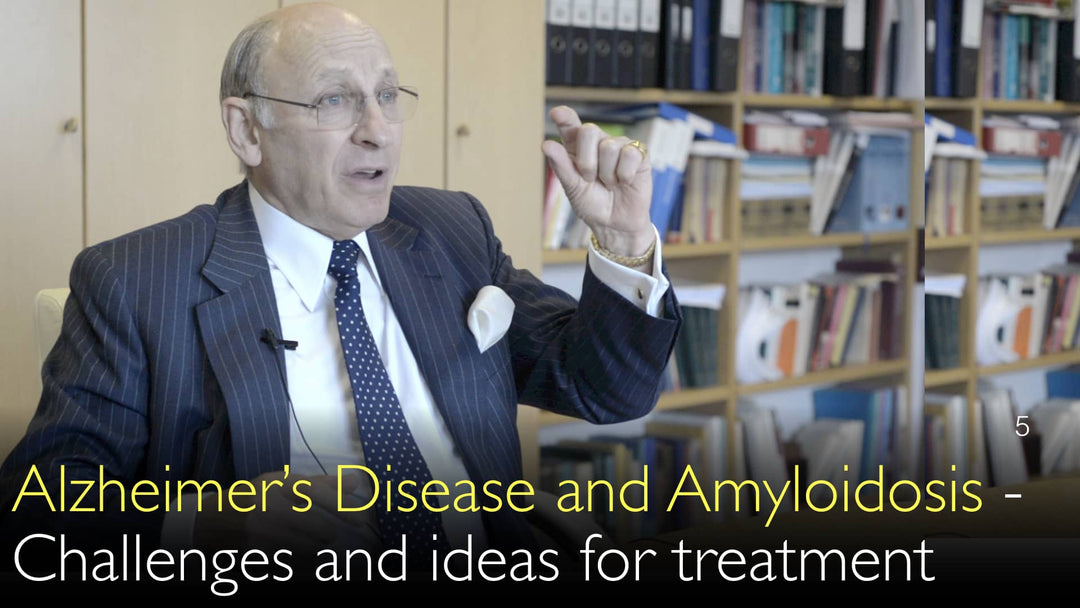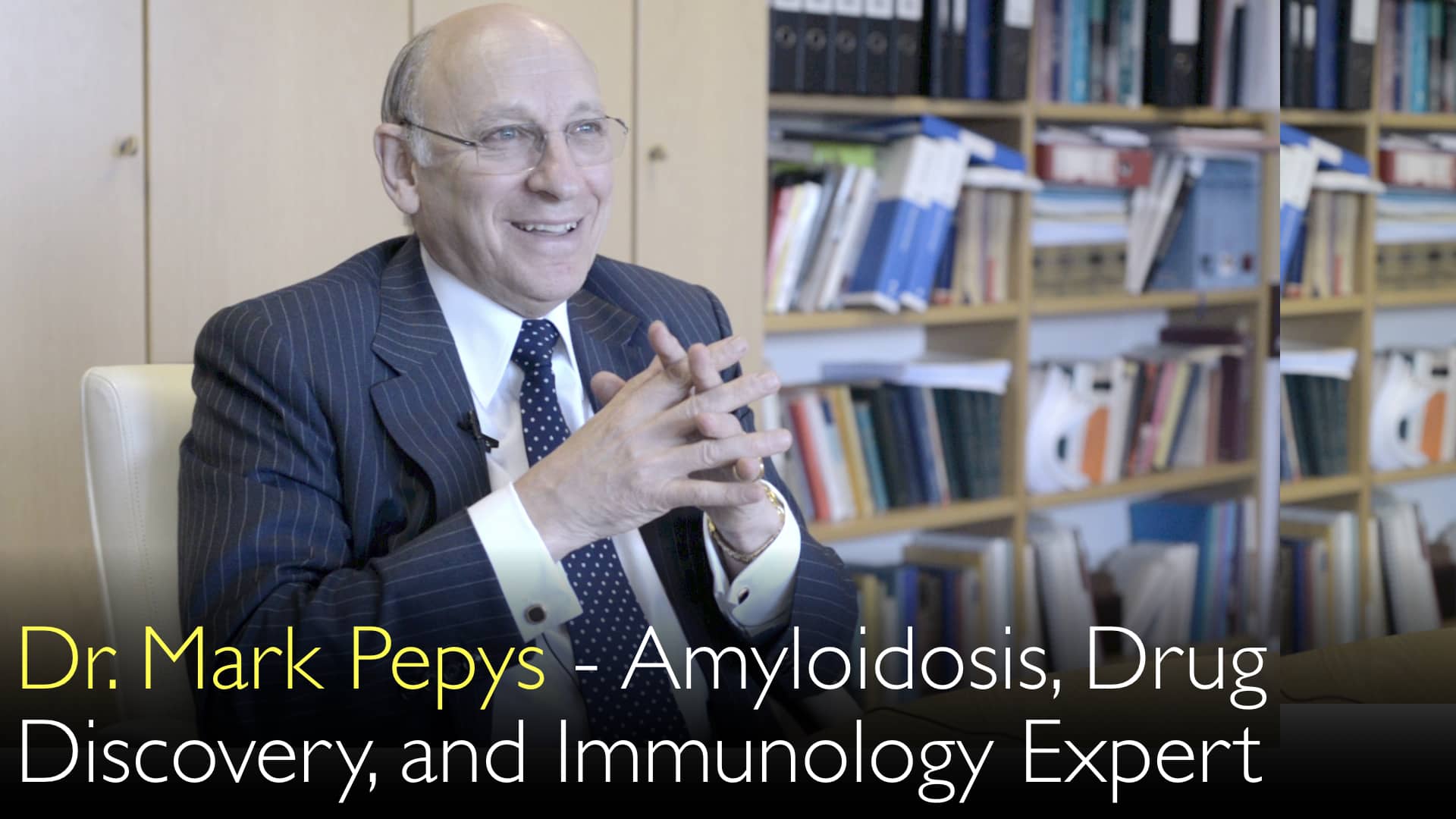Dr. Mark Pepys, MD, en førende ekspert i behandling af amyloidose, forklarer de afgørende forskelle mellem systemisk amyloidose og Alzheimers sygdom. Han præciserer, at Alzheimers sygdom involverer minimale amyloidaflejringer i hjernen, mens systemisk amyloidose kendetegnes ved omfattende aflejringer i organer. Dr. Pepys diskuterer, hvorfor sammenblanding af de to tilstande er klinisk risikabelt, og uddyber sin nye medicin, som fjerner Serum Amyloid P-komponent (SAP) fra hjernen. En ny klinisk undersøgelse vil teste, om denne tilgang kan bremse progressionen af Alzheimers sygdom.
Forståelse af amyloid ved Alzheimers sygdom vs. systemisk amyloidose
Spring til afsnit
- Nøgleforskelle mellem Alzheimers og amyloidose
- Betydningen af præcis diagnostik
- Amyloids rolle i Alzheimers patogenese
- Ny SAP-targeterende behandlingstilgang
- Kommende klinisk forsøg for Alzheimers
- Fuld transskription
Nøgleforskelle mellem Alzheimers og amyloidose
Alzheimers sygdom og systemisk amyloidose er to fundamentalt forskellige tilstande. Ifølge dr. Mark Pepys, MD, involverer Alzheimers mikroskopiske amyloidplader i hjernens væv. Den samlede mængde amyloid i en Alzheimers-hjerne er minimal og udgør kun omkring 100 milligram. Til sammenligning kan systemisk amyloidose give massive amyloidaflejringer i organer som leveren, hvor mængden kan nå op på flere kilo.
Lokalisationen og arten af aflejringerne er også afgørende forskellige. Ved Alzheimers findes amyloid som små ekstracellulære plader sammen med intracellulære neurofibrillære knuder. Ved systemisk amyloidose forekommer aflejringerne i organvæv og blodkarrenes vægge, men ikke i hjernens parenchym. Dr. Anton Titov, MD, og dr. Mark Pepys, MD, diskuterer, hvorfor disse forskelle er afgørende for præcis diagnostik og korrekt behandling.
Betydningen af præcis diagnostik
Korrekt sygdomsklassifikation er afgørende for effektiv patientbehandling. Dr. Mark Pepys, MD, advarer mod at blande termer som "amyloidose" på tværs af forskellige sygdomme. At betegne Alzheimers, Parkinsons eller Huntingtons sygdom som "amyloidose" skaber klinisk forvirring, da hver tilstand har sin egen patofysiologi og kræver specifik behandling.
Denne præcision er særlig vigtig ved systemisk amyloidose. At forveksle arvelig amyloidose med AL-amyloidose kan føre til unødvendig og toksisk cytostatisk kemoterapi. Dr. Mark Pepys, MD, understreger, at diagnostik på molekylært niveau er afgørende. Behandlingsvalg skal baseres på en præcis identifikation af amyloidproteintypen og dens årsag.
Amyloids rolle i Alzheimers patogenese
Sammenhængen mellem amyloidaflejringer og neurodegeneration ved Alzheimers er endnu ikke fuldt ud forstået. Dr. Mark Pepys, MD, bemærker, at selvom amyloid beta-plader er et patologisk kendetegn ved Alzheimers, er deres kausale rolle i nervedød ikke bevist. Tilstedeværelsen af amyloid hænger sammen med Alzheimers sygdom, men forårsager muligvis ikke direkte den kognitive nedgang og demenssymptomer.
Genetisk evidens tyder på, at amyloidvejen er involveret i sygdomsudviklingen. Mutationer i amyloidprekursorproteinet eller processeringsenzymer forårsager arvelig tidligopslået Alzheimers sygdom ved at øge amyloid beta-produktionen. Den præcise mekanisme for nervecelledød er dog stadig ukendt. Tilsvarende usikkerhed gælder for amyloidaflejringer i bugspytkirtlen ved type 2-diabetes, som muligvis er biprodukter snarere end årsager.
Ny SAP-targeterende behandlingstilgang
Dr. Mark Pepys, MD, har udviklet en ny behandling, der målretter Serum Amyloid P-komponent (SAP). Dette normale blodprotein binder til alle amyloidaflejringer, herunder dem i Alzheimers-hjerner. Hans medicin fjerner SAP fuldstændigt fra blodet og dermed også fra hjernen og cerebrospinalvæsken.
Forskning viser to overbevisende virkningsmekanismer for denne tilgang. For det første kan fjernelse af SAP fra amyloidaflejringer hjælpe med at fjerne disse strukturer fra hjernen. For det andet viser nyere evidens, at SAP er direkte toksisk for hjerneceller og forårsager celledød gennem apoptose. Et foreløbigt studie med fem Alzheimers-patienter bekræftede, at medicinen effektivt fjerner SAP fra cerebrospinalvæsken. Dyremodeller viser, at den også fjerner SAP fra amyloidaflejringer i hjernen.
Kommende klinisk forsøg for Alzheimers
Et større klinisk forsøg vil teste denne SAP-målrettede terapi for Alzheimers sygdom. Studiet, finansieret af Storbritanniens National Institute for Health Research, vil inkludere 100 Alzheimers-patienter i et placebokontrolleret, dobbeltblindet forsøg over tre år. Formålet er at afgøre, om fjernelse af SAP kan påvirke sygdomsforløbet og kliniske outcome-mål.
Dr. Mark Pepys, MD, forklarer, at mens tidligere antistofbaserede tilgange rettet mod amyloid beta stort set har fejlet, tager hans metode en anden vej. Ved at målrette SAP i stedet for amyloid direkte, kan behandlingen muligvis overvinde tidligere begrænsninger. Hvis succesfuld, kunne denne terapi potentielt stoppe Alzheimers-progression i tidlige stadier og give signifikant gavn, selvom den ikke kan vende eksisterende neuronskader.
Fuld transskription
Dr. Anton Titov, MD: Hvordan adskiller Alzheimers sygdom og amyloidose sig? Hvad har de til fælles?
Dr. Mark Pepys, MD: Alzheimers sygdom er en helt anden sygdom end systemisk amyloidose. Ved Alzheimers sygdom findes der amyloidaflejringer i hjernens væv. Det ses aldrig ved systemisk amyloidose. Ved systemisk amyloidose kan der være amyloid i hjernehinderne eller i blodkarrene, der forsyner hjernen, men ikke i selve hjernens væv.
Ved Alzheimers sygdom er amyloidaflejringerne i hjernens væv, men de er mikroskopisk små. Den samlede mængde amyloid i hjernen ved Alzheimers sygdom er i milligram. Måske omkring 100 milligram. Det er en meget lille mængde!
Hos personer med klinisk Alzheimers sygdom er der kun en beskeden mængde amyloid. Det er bittesmå mikroskopiske plader. De kaldes amyloidaflejringer.
Neuropatologerne kalder dem plader. Der er også andre unormale proteinstrukturer, kaldet neurofibrillære knuder. De er ikke egentligt amyloid, men ligner i deres opbygning. Disse er de neuropatologiske kendetegn ved Alzheimers sygdom, men de findes i meget små mængder.
I leveren hos en person med systemisk amyloidose kan der derimod være op til 5 kilogram amyloid. Det er en helt anden situation.
5 kilogram versus få milligram? Ja. Jeg kalder ikke Alzheimers sygdom for "amyloidose". Det er meget vigtigt i medicinen at navngive sygdomme korrekt.
Fordi neurowidenskabsmænd og mange biokemikere og biofysikere arbejder inden for dette område, men de er ikke kliniske læger. De bruger ordene meget løst. Dette er et ret kontroversielt emne. Når man er klinisk læge og passer patienter, betyder navngivningen virkelig noget.
Man bruger et specifikt ord til én diagnose, som kræver én behandling. Hvis man bruger det samme ord til en anden sygdom, som kræver en helt anden behandling, kan det blive en katastrofe!
Desværre er der en nutidig tendens, som sandsynligvis er svær at standse. Indflydelsen fra grundforskere har i vis omfang spredt sig til den kliniske verden. Folk kalder Alzheimers sygdom, Parkinsons sygdom og Huntingtons sygdom for "amyloidose", fordi de deler visse molekylære ligheder.
Der er en fælles metode for unormale proteinstrukturer, men de er ikke amyloidose. Ved Huntingtons sygdom er det unormale materiale i cellens kerne. Ved Parkinsons sygdom er amyloid i cellens cytoplasma. Ved Alzheimers sygdom er amyloid udenfor cellerne.
Dette er velkendt. Det svarer til amyloidose andre steder. Men alle disse sygdomme er helt forskellige. De er mere forskellige end at forsøge at lave længdespring på Jorden, Månen og Mars. Disse steder har forskellig atmosfære og tyngdekraft.
Miljøet inde i cellens kerne, i cytoplasmaet og udenfor cellen er også helt forskelligt. Det er meget vigtigt ikke at sammenblande disse ting. Sammen
Dr. Anton Titov, MD: Det var det første, der skulle siges. Lad os vende tilbage til mine forslag til behandling af Alzheimers sygdom.
Dr. Mark Pepys, MD: Oprindeligt ønskede jeg, at kroppen skulle fjerne amyloidaflejringerne i hjernen ved Alzheimers sygdom. Det kan man gøre ved at fjerne SAP (serum amyloid P-komponent) fra hjernen ved hjælp af vores lille molekylemedicin. Jeg synes stadig, det er en meget god idé. Vi er ved at starte en klinisk undersøgelse for netop at teste denne terapi ved Alzheimers sygdom.
Det var den oprindelige begrundelse. Hvis man kan finde en behandling, der fjerner amyloid fra hjernen hos personer med Alzheimers sygdom, kan sygdommen måske standses. Eller patienterne bliver mirakuløst bedre. Det er dog usandsynligt, når man har mistet hjerneceller, fordi man ikke kan erstatte døde neuroner.
Man kunne i det mindste standse sygdomsforløbet på et tidligt stadium. Det ville have en dramatisk indvirkning på det kliniske billede. En behandling, der fjernede amyloid, ville også være en god måde at teste hypotesen om, hvorvidt amyloidaflejringerne selv er skadelige.
Men indtil videre har ingen sådan behandling vist sig effektiv.
Dr. Anton Titov, MD: Der har været forskellige forsøg på at bruge antistoffer mod A-beta. Antistoffer kunne i hjernen gøre det, jeg har gjort med succes ved systemisk amyloidose i andre organer. Der er brugt milliarder af dollars på kliniske forsøg ved Alzheimers sygdom.
Dr. Mark Pepys, MD: De har endnu ikke haft nogen succes. For nylig er der kommet nogle muligvis lovende resultater. Nogle gange tager man patienter med mild Alzheimers sygdom, der behandles tidligt, og det ser lovende ud. Måske er der tegn på forbedring med passende antistofadministration. Men der er lang vej til at bevise det.
De fleste af disse behandlinger har fejlet på grund af manglende effekt eller toksicitet. Min behandlingsmetode er anderledes.
Jeg har en medicin, der fjerner SAP fuldstændigt. Den fjerner SAP-protein næsten helt fra blodet. SAP dannes kun i leveren. Der findes SAP i hjernen i en meget lav koncentration – omkring en tusindedel af koncentrationen i blodet.
Men ved at fjerne alt SAP fra blodet fjernes det også fra hjernen. Vi har foretaget en foreløbig undersøgelse på 5 patienter med Alzheimers sygdom. De fik vores medicin i tre måneder, og det fjernede fuldstændigt alt SAP fra cerebrospinalvæsken. Cerebrospinalvæsken omvasker hjernen.
For nylig udførte vi dyreforsøg med en model for Alzheimers sygdom med amyloid i hjernen. Vi viste, at vores medicin fjerner alt SAP fra disse amyloidaflejringer. Der er meget stærk evidens for, at medicinen vil gøre, hvad vi ønsker biokemisk.
Vores medicin fjerner SAP fra amyloidaflejringerne i hjernen. Det er én vej til en medicinsk behandling af Alzheimers sygdom. Det er en gammel idé for mig – jeg har haft den i 20 år. Nu tester vi den.
Men i mellemtiden har adskillige andre laboratorier vist, at humant SAP faktisk er toksisk for hjerneceller.
Dr. Anton Titov, MD: Nogle gange dyrker man hjerneceller i vævskultur og udsætter dem for humant SAP. Så dør neuronerne. Da jeg først læste disse forskningsartikler, syntes de meget interessante. Da jeg læste dem nøjere, var jeg mindre overbevist.
Dr. Mark Pepys, MD: Jeg var ikke overbevist om renheden af det protein, de brugte. De brugte kommercielt købte proteiner, som muligvis ikke var autentiske eller rene. Så jeg var ret skeptisk.
Logisk set – hvorfor skulle et normalt blodprotein dræbe ens hjerneceller? Det virker mærkeligt! Men faktum er, at vi kan gentage disse observationer. De er robust reproducerbare. Humant SAP er skadeligt for hjerneceller. Neuroner dør.
SAP-protein binder til neuroner, kommer ind i cellerne og ind i cellernes kerne. Cellerne dør så ved apoptose. Vi kender endnu ikke de præcise molekylære mekanismer, men observationen er reproducerbar med højrent farmaceutisk kvalitets-SAP, som vi unikt har i vores laboratorium.
Dette er nu en overbevisende anden begrundelse for vores medicin til at fjerne dette protein fra blodet og hjernen. Min nuværende hypotese er, at SAP bidrager til dannelse og persistens af amyloidplader ved Alzheimers sygdom og også er skadeligt for hjernen.
Ved Alzheimers sygdom har man disse plader af amyloid og neurofibrillære knuder, som alle er belagt med SAP. Der er en unormalt forhøjet mængde SAP i hjernen hos patienter med Alzheimers sygdom. SAP er skadeligt for hjernen. Lad os slippe af med det!
Det er begrundelsen for vores kliniske forsøg. Dette er nu finansieret af National Institute for Health Research i Storbritannien. Vi vil undersøge 100 patienter med Alzheimers sygdom i et placebokontrolleret, dobbeltblindet klinisk forsøg over tre år. Vi vil se, om det har nogen indvirkning på sygdommen. Det er, hvad vi gør.





